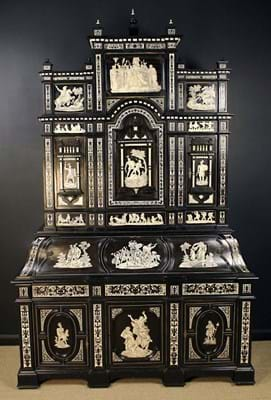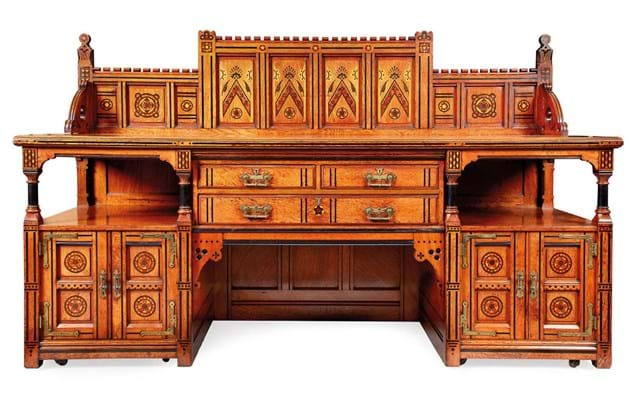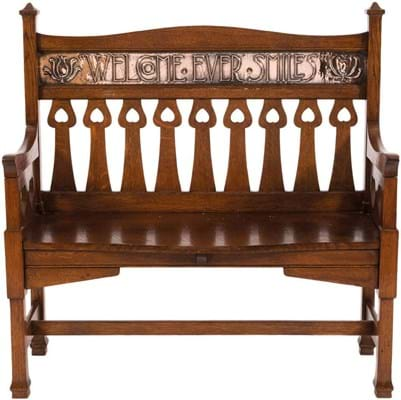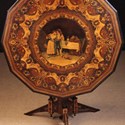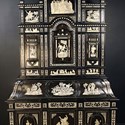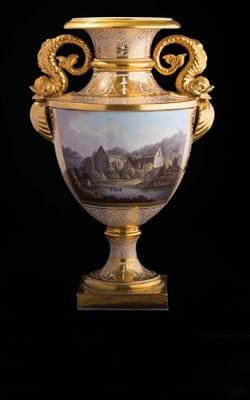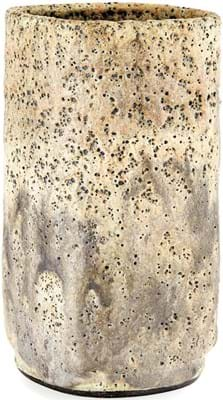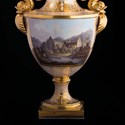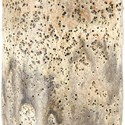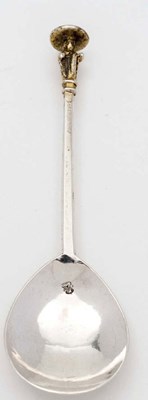At Bearnes Hampton & Littlewood (21% buyer’s premium) at Exeter on April 11-12, 1110 lots enjoyed a 78% success rate and a hammer total of £787,000.
At Lyon & Turnbull’s (25% buyer’s premium) sale of Post-1860 Design at Edinburgh on April 26 the equivalent figures were 557 lots, 73% and £434,000.
For Wilkinson’s (17.5% buyer’s premium) at Doncaster on April 23 they read 615, 73% and £305,000.
Furniture in Doncaster
At Wilkinson’s, Continental furniture was a major draw for bidders in a full saleroom, online and on the phones.
Best-seller was a rare 19th century Italian Sorrento marquetry tilt-topped table.
Typical of its type, produced for wealthy tourists to Sorrento in the 19th century and which generally command interest today, this one was of exhibition quality.
The 3ft 3½in (1m) wide, 12-sided top was richly inlaid with a scene of a young man and woman flirting as a monk looks on. Enhanced by painted details and signed by the artist, the scene was framed within bands of intricate marquetry.
Estimated at £16,000-18,000, it sold at £20,000 to a Chinese buyer based in south-east England. For auctioneer Matt Gibson it was further evidence of Chinese interest in at least some European furniture and clocks.
Decorative 19th century centre tables from the Continent were extremely popular.
A small example from eastern Europe with a 16½in (42cm) wide oval top featured a pierced silver-metal gallery rail and a central porcelain plaque of a jolly couple seated on a bench. It sold within estimate at £3800.
Of undetermined origin, possibly France or Italy but not in the same league as the Sorrento table, was one painted to the 4ft 6in (1.37m) wide rectangular top with panels of country folk at leisure.
Estimated at £600-800, it went to a UK buyer at £3400.
The 8ft 9in high x 5ft 11in wide (2.67 x 1.8m) piece was profusely inlaid with ivory depicting allegorical scenes in panels and contra partie ivory foliage to the pilasters and divides. Estimated at £2000-4000, it sold at £12,500 to a northern European bidder.
From France a 19th century Louis XVI-style bureau plat, 3ft 8½in (1.13m) wide with boulle work and gilt bronze caryatid mounts to the cabriole legs, went just shy of the estimate at £5800.
A 19th century Chinese hardwood display cabinet, 6ft 10in (2.09m) tall and intricately pierced and carved throughout with undulating foliage went to the Far East a shade over estimate at £8200.
Quality English pieces also got away, selling to UK buyers.
A pair of highly decorative 19th century pair of 3ft 6in (1.08m) wide kingwood side cabinets. with ebonised borders and panels with relief-cast plaques of figures in landscapes sold a shade below estimate at £7200.
Heftier pieces included a 7ft 7in (2.31m) tall mahogany breakfront bookcase in the manner of Gillows and a 6ft 10in tall x 3ft 5in wide (2.08 x 1.03m) George I burr elm and walnut bureau cabinet.
The bookcase went a shade below estimate at £7000. The cabinet, with arched mirrored doors enclosing pigeon holes above a feather-banded base with a fall, went within expectations at £4600.
Down to Exeter
It was furniture with something extra or unusual which was in demand at BHL’s Exeter sale.
One such was a yew and marquetry Killarney games table.
A familiar piece from the Killarney craftsmen whose marquetry work was so coveted by mid to late 19th century tourists, it had a crossbanded hinged top with leaf sprays and panels of buildings opening to a surface decorated for backgammon, chess and cribbage.
The 2ft (61cm) wide table was more restrained than the all-over marquetry Killarney pieces such as the davenport which took €31,000 (then about £28,500) at James Adams’ Drogheda sale last October. Estimated at £800-1200, it sold to the Irish trade at £3500.
Produced much nearer to the auction rooms was an Arts & Crafts oak settle by Barnstaple maker Shapland & Petter.
The 3ft (92cm) wide settle was consigned to Exeter from Ireland by a vendor who recalled BHL selling a very similar piece four years back at £2800.
It featured a copper panel inset into the top rail Welcome Ever Smiles, a quote from Troilus and Cressida, and shaped vertical splats headed with inverted hearts.
Estimated at £2000-2500, the settle sold to a collector at £5200.
Up in Edinburgh
Shapland & Petter also featured among the Arts & Crafts material at Lyon & Turnbull’s Edinburgh sale in the form of a c.1900, 6ft 7in high x 7ft 3in wide (2.22 x 2m) oak bookcase cabinet.
With an arched gallery above a breakfront centre section of shelves, and a cupboard featuring a polychrome panel inscribed My Lady’s Garden flanked by shelves, and all above three panelled doors, it sold at the lower £4000 estimate.
Furniture with Scottish links, not surprisingly, made a big impact.
Ernest Archibald Taylor (1874-1951) was one of the number of designers to emerge from the Glasgow School of Art, where he met his future wife, the illustrator and jewellery designer Jessie King. Working for the renowned Glasgow cabinetmakers Wylie & Lochhead, he gained a reputation as a designer of both furniture and stained glass.
His c.1900 oak bureau chest – five drawers below a fall flanked by shaped uprights – combined both talents, with inset glass panels to the galleried back and uprights.
Standing 4ft 5in tall x 2ft 4in wide (1.34m x 72cm), it sold at the lower £8000 estimate.
A c.1890 walnut refectory table was by George Washington Jack (1855-1931), the New York-born, Glasgow-raised architect who worked in London from about 1880 as a furniture designer and was closely linked to Morris & Co.
With a 7ft 6in long x 3ft 6in (2.29 x 1.07m) wide top, on six legs joined by a haymaker stretcher, it sold on the lower estimate at £10,000.
Sir Basil Spence’s (1907-76) post-war collaboration with Morris of Glasgow resulted in, among other pieces, the famous laminated wood Allegro dining suite pieces which appear on the market from time to time.
L&T offered a 5ft 5in (1.65m) long dining table and a 5ft 3in (1.6m) wide sideboard dated 1947-48. Estimated at £3000-5000, they sold at £8600.
Robert Lorimer’s (1864-1929) 5ft (1.52m) long, limed oak centre table, designed c.1924 for Liberty’s ‘Tudor’ headquarters in Soho, took a mid-estimate £4000.
Charles Bevan (c.1820-82) was a ‘modern Gothic designer’ who worked for major manufactures including Gillows. Two c.1870 pieces attributed to Bevan for Marsh & Jones of Leeds were offered at Edinburgh: a sideboard and a secretaire cabinet each in typical ‘Gothic Revival’ style.
The 8ft (2.44m) wide sideboard had a stepped castellated superstructure inlaid with specimen woods. The 6ft 10in (2.08m) wide, inlaid oak cabinet featured a galleried superstructure above six panels, each carved in bas relief, the upper three opening to reveal a fitted interior and the lower three being cupboard doors.
Each sold on mid-estimate, the sideboard at £7000 and the secretaire cabinet at £4300.
Surrounded by such interesting decorative work, it was a simple adzed oak refectory table by Robert ‘Mouseman’ Thompson (1876-1955) which topped the Edinburgh furniture.
Crucially, the 7ft 9in long x 2ft 11in (2.35m x 89cm) wide table was dated 1930, an early work from the Kilburn workshop. Against a £5000-7000 estimate it sold at £11,000.
Ceramics
Surviving the collapse of late 18th century and early 19th century English porcelain better than most have been the hugely decorative Worcester pieces produced under various combinations of the Flight and Barr era.
Hence the delight of auctioneer Nic Saintey at BHL when part of the large collection of such material amassed by Torquay collector-dealer Derek O’Donoghue – a major source of Henry Sandon’s reference book Flight and Barr Worcester Porcelain – was consigned to the Exeter rooms after O’Donoghue’s death in January.
Best of the five pieces from the first tranche at Exeter was a 13in (33cm) tall Barr, Flight & Barr vase with gilt dolphin and shell handles dating from 1805-10.
Featuring a view of Tintern Abbey in Monmouthshire, it was estimated at £3000-5000 and sold to a local collector at £7200.
Going within estimate, a 1815-20 pair of Flight, Barr & Barr two-handled urns of neo-classical design took £4300. A pair of Flight Barr & Barr Warwick Vase urns from 1820-30 painted with birds and a lakeside scene, probably by Charles Stinton, made £2900.
These are not huge prices in a historical sense, as Saintey acknowledged, but with a promise of more to come in future sales.
“Prices are soft at present,” he said. “We have saved the ‘best’ marbled, feather and shell-painted Flight, Barr & Barr for the next fine sale on July 11-12.”
Earliest of the ceramics at Exeter was a rare c.1740-50 Bristol delftware bow painted in bright enamels with Chinese figures by a lake. At 13½in (34cm) diameter wide it was, Saintey believed, to be larger than any Bristol delft bowl offered in recent memory.
Apart from a shallow star crack it was in fine condition and, against a £1000-2000 estimate, sold to the trade at £4700.
Ceramics at L&T’s design sale included a stoneware vessel by Dame Lucie Rie whose high-end works were discussed in ATG 2291.
The Edinburgh offering was a plainer, more affordable example – a 9in (23cm) square section vessel with a pitted volcanic glaze and a seal mark LR. Nevertheless, it left a £1500-2500 estimate behind to sell at £6000.
Silver and bronze
Top silver at the three sales was another piece related to the Arts & Crafts movement, a cup and cover designed by Charles Robert Ashbee (1863-1942), prime mover in the Guild of Handicrafts.
It was hallmarked London 1901, the year before the guild moved from its struggling east London base to Chipping Camden for the final five years of its existence. The 15in (37.5cm) tall, 16oz cup with planished surface and set with green chrysoprase cabochons was stamped GofHLtd. Estimated at a modest £3000-5000, it sold at £24,000.
That price was bettered at Edinburgh only by a bronze by a contemporary of Ashbee and leading figure in the New Sculpture movement of the late 19th century, Sir George Frampton (1860-1928).
The 19in (48cm) bronze was a reduction of his famous statue of Peter Pan which JM Barrie commissioned in 1910 for Kensington Garden. Signed in the bronze Geo. Frampton, dated 1915 and inscribed with an encircled PP, it sold within estimate at £28,000.
At BHL in Exeter the best price for silver came for a 2007 jug by Norfolk silversmith Rod Kelly. His highly chased work is increasingly popular as it begins to trickle on to the secondary market.
This 42oz jug, given a nominal estimate of £400-600, took a £7000 bid from a Home Counties dealer.
Collector interest focused on a 7¼in (18.5cm) long, 2oz apostle spoon by Thomas Dare I who was active in Taunton from 1625-60. A very similar spoon made £460 at Roseberys of West Norwood three years ago and the Exeter lot was estimated at £300-500. Possibly the Somerset connection helped: it sold to a West Country collector at £2100.
Clocks
Clocks at BHL ranged across three full centuries, from a 1974 diamond, gold and green enamelled decorative timepiece by Asprey which went to an American bidder at £4400 to a mid-1670s 40-hour brass lantern clock engraved to the 5½in (14cm) dial Thomas Savidge, Exeter. Local interest pushed the bidding along but the clock went to a Home Counties collector at £2400, double the top estimate.
Rather unusually, the top clock was a longcase. Signed to the square brass dial by the late 17th/early 18th century clocksmith Richard Roker, London, and in a 6ft 1in (1.85m) tall restored walnut marquetry case it was a private buy at a mid-estimate £10,000.
Another early 18th century figured walnut longcase, 7ft 10in (2.94m) tall and inscribed to the 12in (30cm) brass dial William Tomlinson, London, took a mid-estimate £5000 from the home trade at Wilkinson’s.



